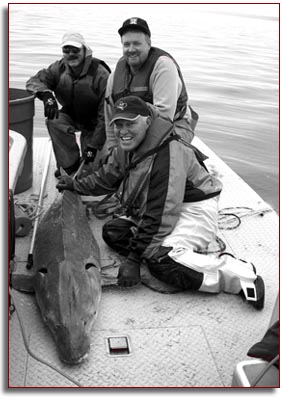 |
|
From Left: Scott Mettee and Stuart McGregor of the
Geological Survey of Alabama and Jerry Moss of the Wildlife and
Freshwater Fisheries Division of the Department of Conservation with
the Gulf sturgeon caught and released from Mobile Bay on February 21,
2006 |
March 13, 2006
Biologists from the Geological Survey of Alabama (GSA), Alabama Wildlife
and Freshwater Fisheries Division (WFFD), and the U.S. Fish and Wildlife
Service (USFWS) caught and released a 160 pound Gulf sturgeon near Fairhope
in Mobile Bay on Feb. 21, 2006. A small tag found near the dorsal fin
indicated the USFWS had tagged the fish in the lower Choctawhatchee River
in northwest Florida in 1999.
The range of the Gulf sturgeon extends along the northern Gulf coast from
Lake Ponchartrain in Louisiana to the Suwannee River in Florida. This is an
anadromous fish species, meaning individuals spend most of their lives in
salt water and migrate into freshwater rivers to spawn. After spawning,
they remain in fresh water for several weeks before returning to salt
water. Newly hatched sturgeon remain in fresh water for several months
before moving downstream into bays and estuaries. Adult sturgeon do not
feed while in fresh water.
In the late 1800s and early 1900s newspaper reports and photographs
documented that large Gulf sturgeon exceeding several hundred pounds
inhabited the Alabama, Cahaba, Coosa, and Tallapoosa Rivers. The species
eventually disappeared from the area due in part to over-harvest and the
construction of high-lift locks and dams, which blocked upstream migrations
to inland spawning habitats. Fearing species numbers would continue to
decline throughout the range, the USFWS listed the Gulf sturgeon as a
threatened species under the endangered Species Act in 1991.
In 2005, the WFFD and GSA initiated a cooperative study with funding from
the State Wildlife Grants program to gather information on Gulf sturgeon
numbers, movements, and life history in Mobile and Perdido Bays and their
contributing rivers. Sturgeon will be collected, measured and weighed from
March through April. Each fish will receive an ultrasonic tag that
transmits a distinctive signal for 36 to 48 months. Tracking will range
throughout the study area, in an effort to find the tagged fish. If a fish
is detected, its location will be recorded on a Global Positioning System
receiver, and all of its locality data will be used to create a map showing
movement patterns. Water quality and bottom data collected at each site
will be used to characterize sturgeon habitat in Alabama waters.
A second goal of the study is to identify Gulf sturgeon spawning habitats
in the Alabama and Tombigbee Rivers. Egg collecting devices will be placed
at various locations in the lower reaches of both rivers and checked every
two to three days from March through April. Eggs will be removed and placed
in aquariums to hatch. A few eggs will be used for DNA tests. Hatched
larvae will be transported back to their original collection site.
This study is intended to contribute to the overall understanding of the
life history requirements of this unique fish throughout the Gulf coast.
The eventual goal is to reverse its decline and work toward its removal
from the need for Endangered Species Act protection.
The Alabama Department of Conservation and Natural Resources promotes wise
stewardship, management and enjoyment of Alabama’s natural resources
through five divisions: Marine Police, Marine Resources, State Parks, State
Lands, and Wildlife and Freshwater Fisheries. |